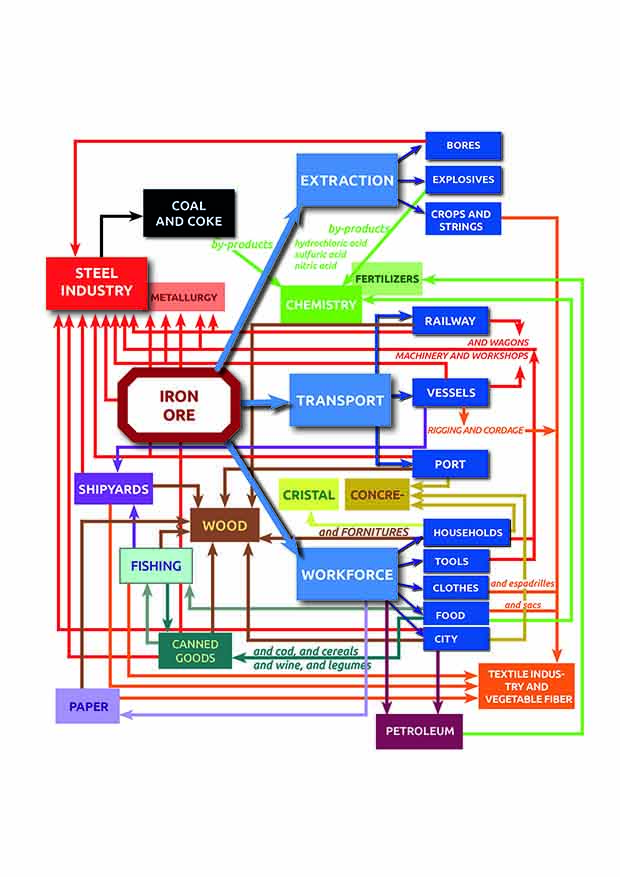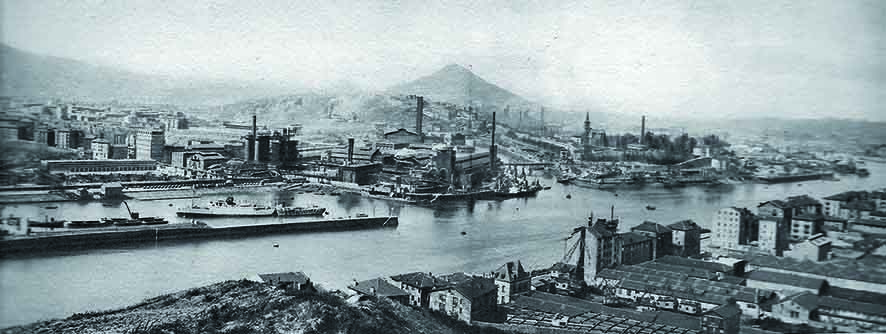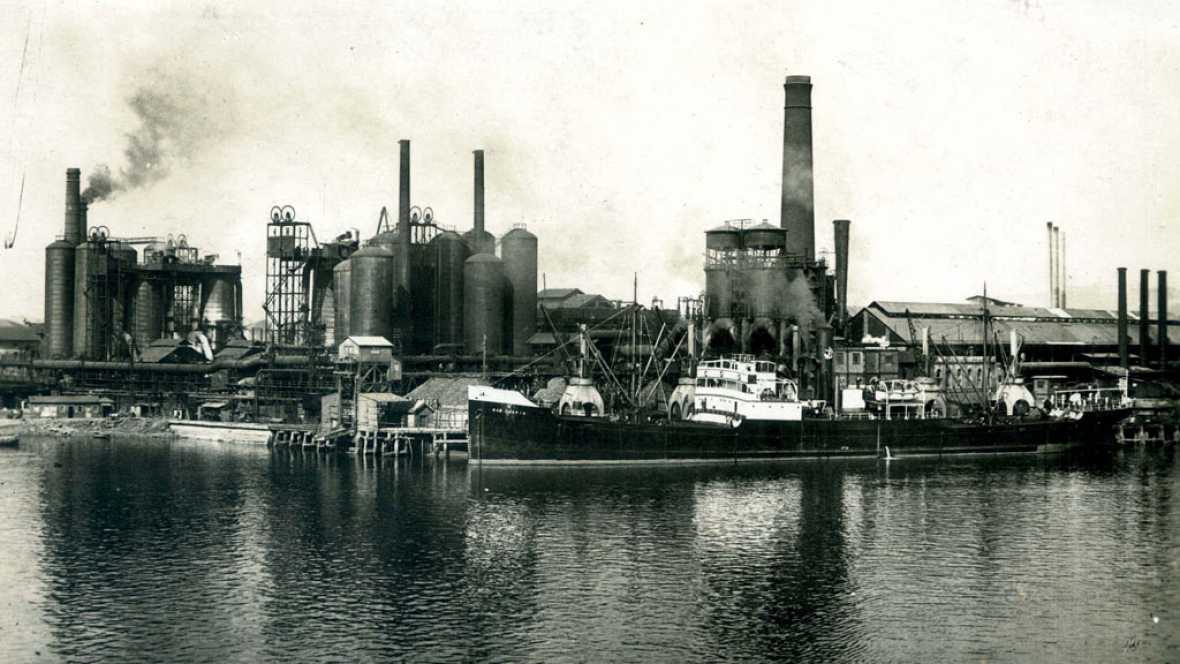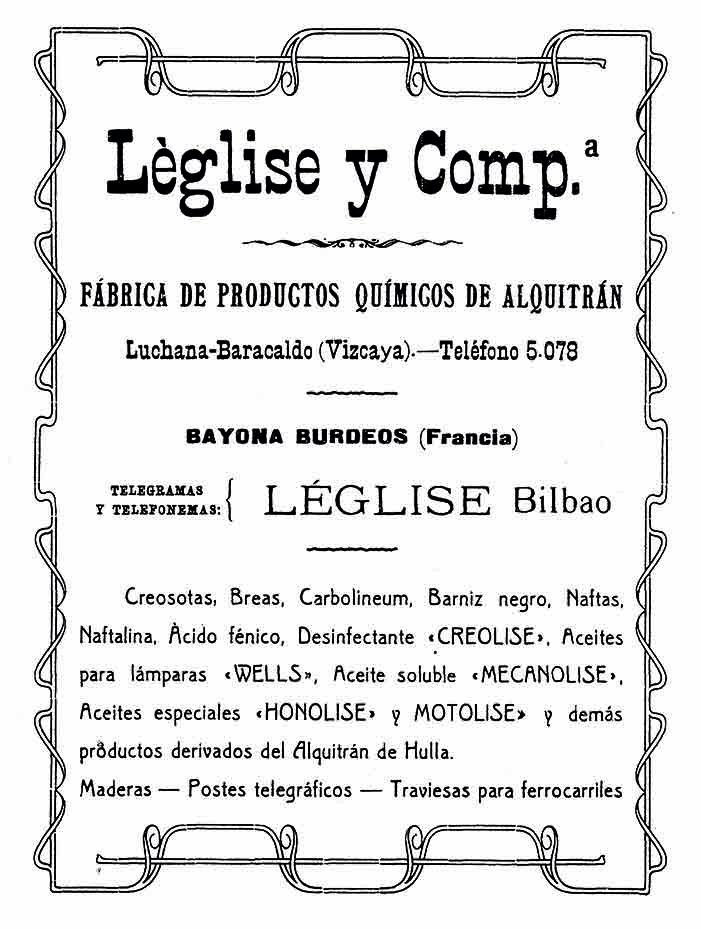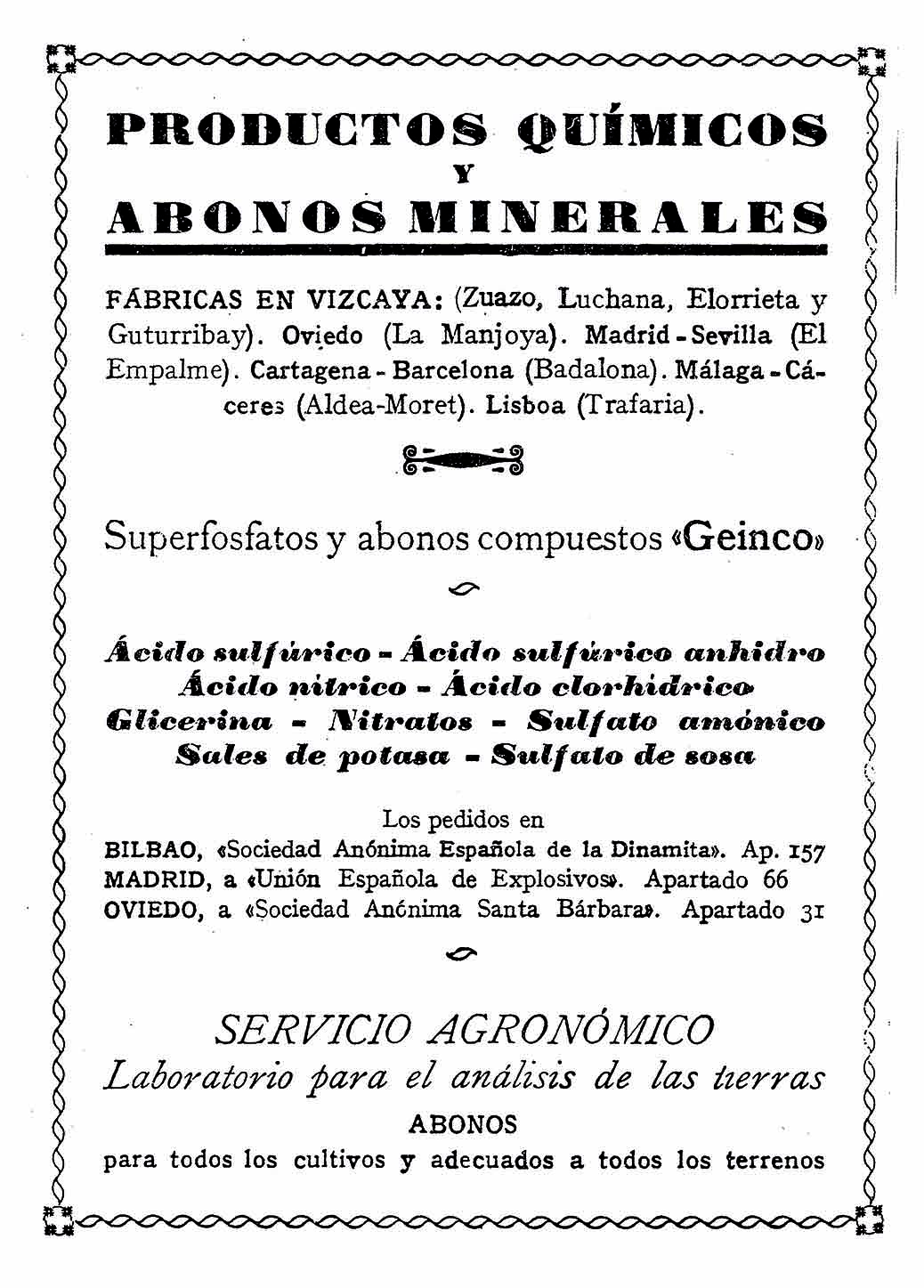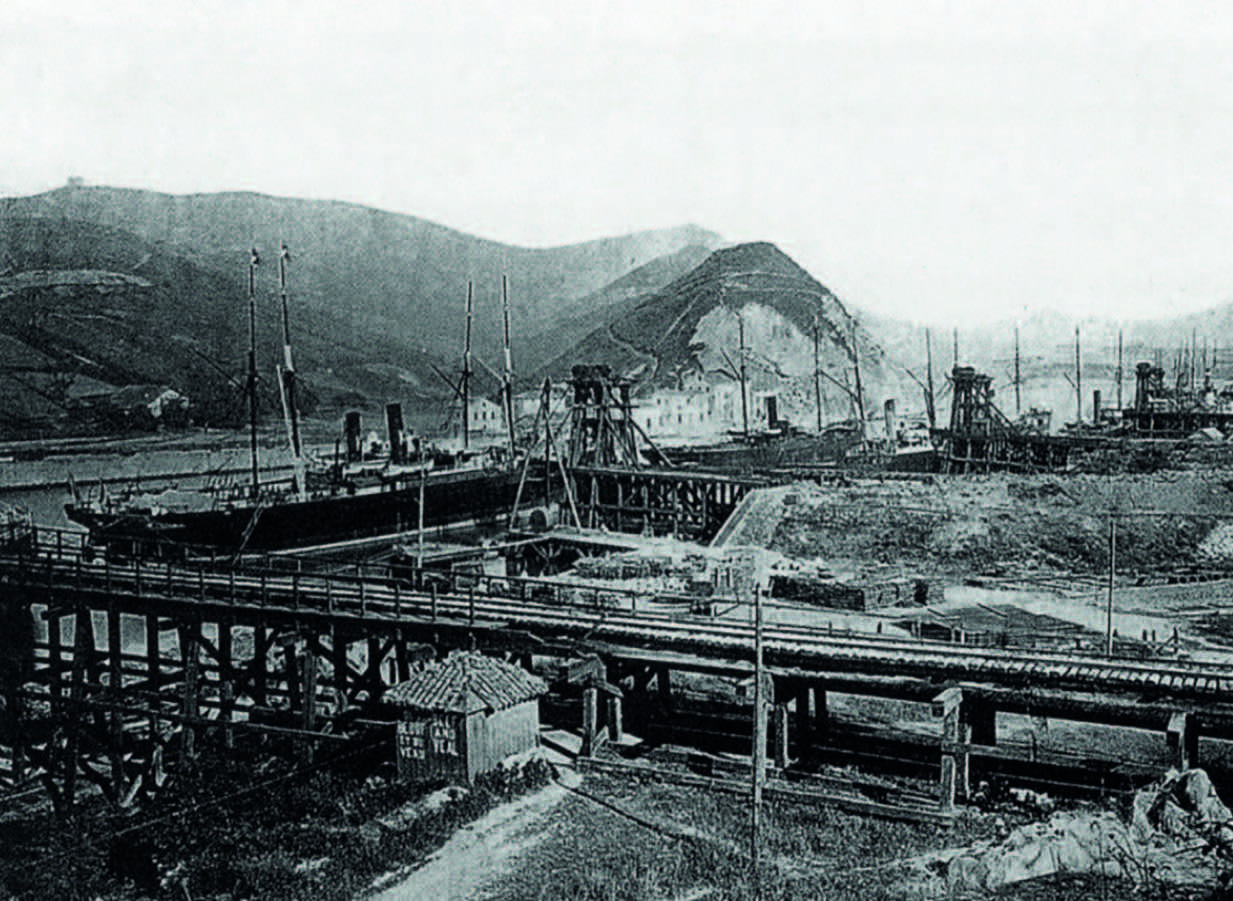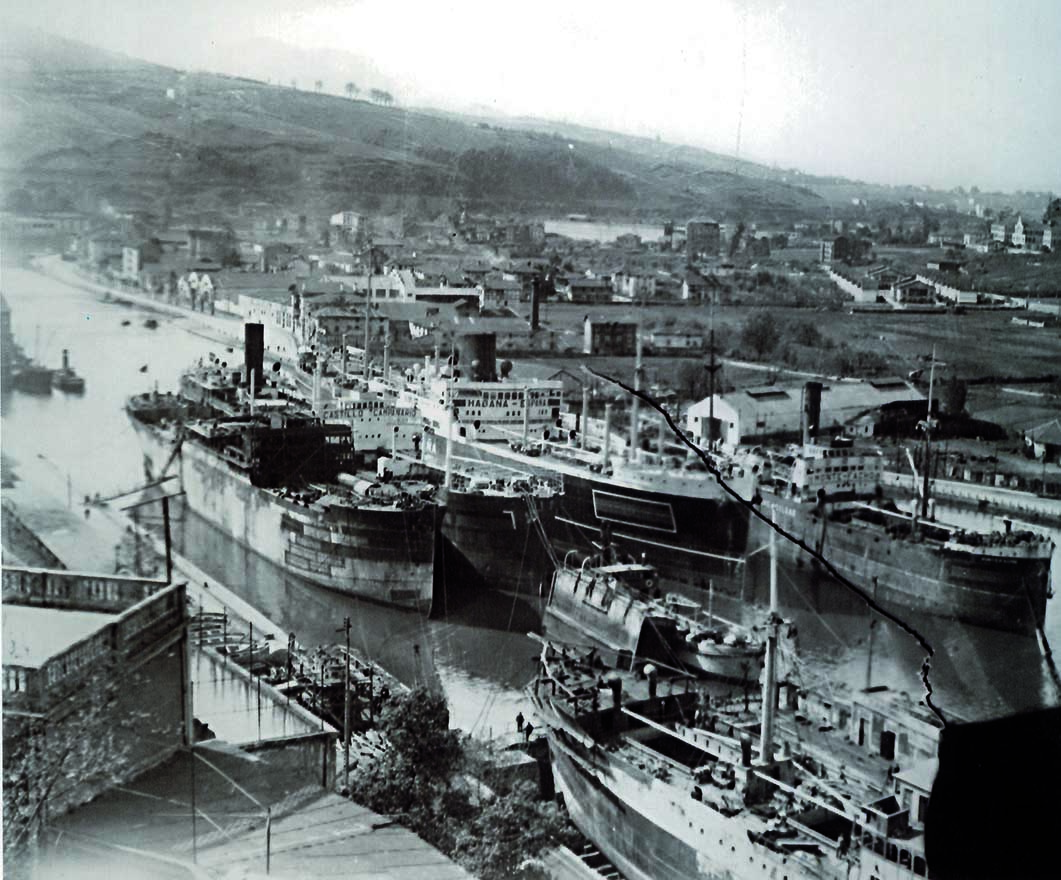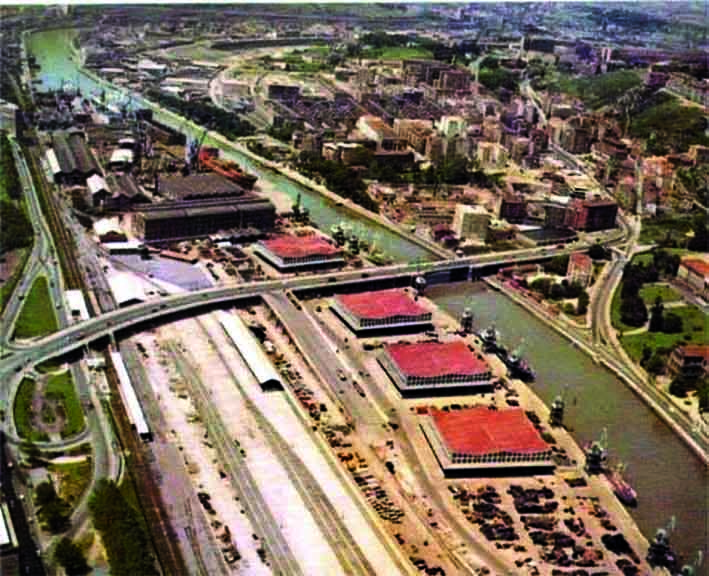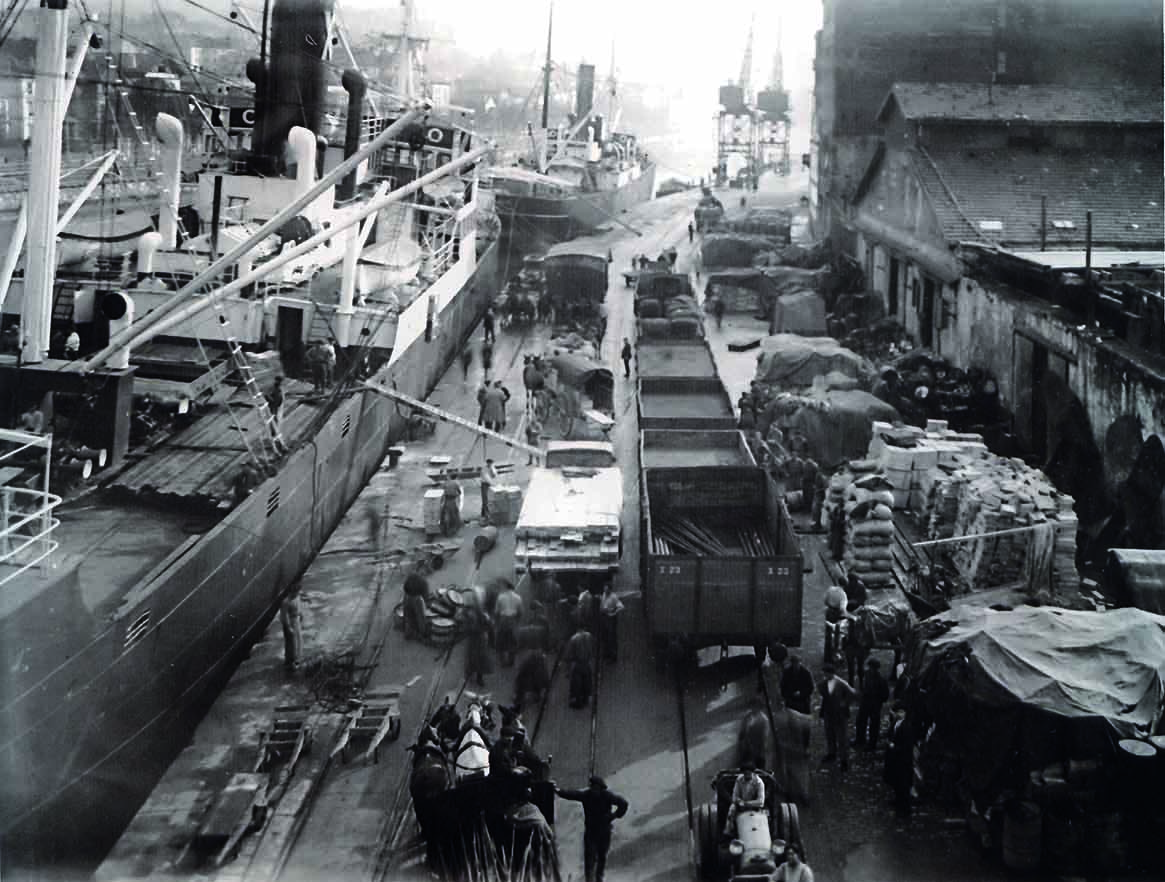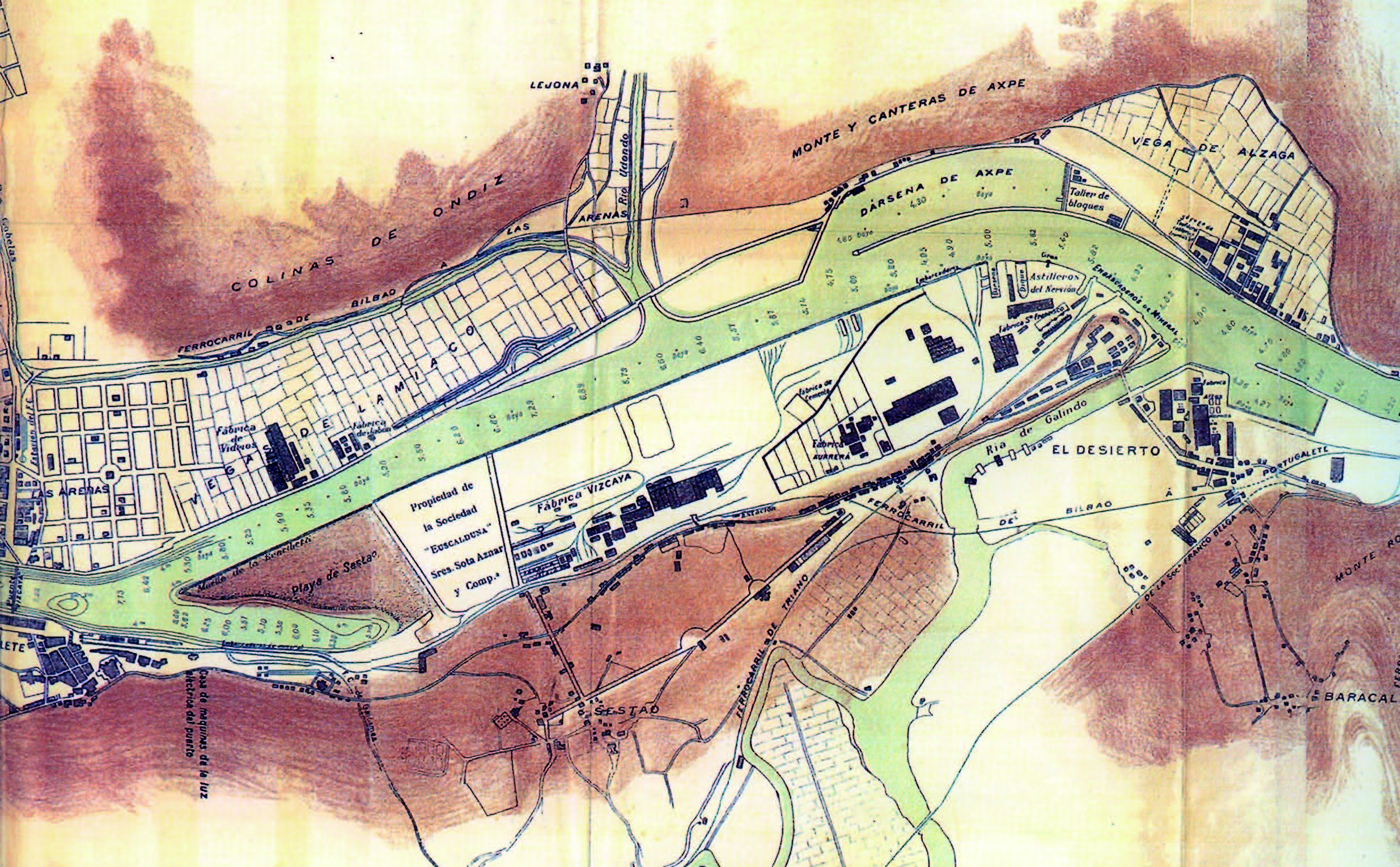In this coming and going between the collective memory and the History, we are privileged witnesses of the transformation that is taking place in the economic, social and political life of our country. If we succumb to the temptation to reflect on the experiences and circumstances of our reality, we see that they are nothing more than the reproduction of what a hundred years ago other people lived with the same uncertainty and restlessness. The light of History can help us to reach some keys that allow us to walk with more confidence towards the future. Do not forget that, in the opinion of George Orwell, “Who controls the past, controls the future“.
In the maritime trade, we can see three interrelated elements, the port, the vessels and the merchandise. The port is the static element, which has to do with the physical structure of transport: the execution of the works, conservation of the draft, buildings and facilities on the docks, the tooling, and so on. The vessels and the merchandise constitute the dynamic component of the commercial activity, which concerns navigation: maritime traffic, anchoring, berthing, docking and undocking, towing, loading and downloading operations, storage, naval aid, and so force. It is essential that these three elements be perfectly coordinated to meet the requirements of regularity, frequency, reliability, speed and safety in transport to provide maximum performance to maritime trade. We would say that the synergy that is established between the merchandise, the vessel and the port, conditions and determines the maritime commercial activity.
In the first half of the nineteenth century, the commercial activity of the port of Bilbao had as its scenario two wars that devastated the country: the war against the French and the first Carlist war. The traditional activity of iron began to modernise its facilities by the middle of the century, and the technique had evolved towards high charcoal ovens. However, in the mid-1860s, a new element appeared in port activity: obtaining steel through the Bessemer converter, which required an iron ore devoid of sulphur and phosphorus. This characteristic only occurred in Europe in the mines of Sweden, underground, and in the mountains of Triano, Bizkaia, in the open air. Thus began the massive export of iron ore caused by a significant demand from abroad, mainly the United Kingdom. The deployment of mining extractive activity that caused the influx of vessels of higher capacity on the one hand and technological advances in shipyards, metal hull, steam navigation, propeller and so on, by the other, they caused the need for upper depths in the port and suitable berths. Dozens of mining companies were installed, including 64 English companies, which employed more than 15,000 people and by the end of the century produced six and a half million tons of iron per year, a tenth of the world’s production at that time.
The port of Bilbao had to adapt its installations to serve the new industrial activity that had to be developed. It was necessary to bring the iron ore to the docks, but the loading and downloading of the ships in Bilbao suffered numerous delays due to the difficulty to enter and leave the port. The presence of banks of quicksand at the mouth of the estuary, with powerful waves just in the barre, was a significant obstacle to access to the port, and internal navigation suffered considerable difficulties for commercial development. The irregular curves of the margins, the narrowness of the channel and the lack of depth forced the boats to anchor in Olabeaga, 4 km from the heart of the town, and download the goods to barges to go up to Bilbao. This cost of lighterage severely taxed the final price of the items traded.
The conditioning of the port to the new industrial needs, which arose with the mining extractive industry and with the modern steel industry, stimulated the adaptation of the territory to the new activity. Rivers were diverted; giant holes were opened in the iron mountains of which Pliny spoke. Furnaces were installed to calcinate the iron; aerial trams were laid to be lowered in buckets to loading docks, inclined planes were built for the wagons. Moreover, the densest railway network in Europe was laid out: 100 km of the railroad for 2,200 km2.
In the period from 1878 to 1902, the river was channelled by arranging berths and moorings; the Portugalete barre was eliminated. This fact allowed deep-draft vessels to enter, and an outer port was established with drafts between 5 and 15 m of depth in the low tide, admitting in these tides ships of up to 15,25 meters draft. Bilbao, which had traditionally been an importing centre for food products and goods, became an export port for iron by-products and industrial products produced on the left margin of the river.
The iron ore activity needs the combination of three elements: the Extraction, the Transportation and the Workforce. Without looking for being exhaustive, I will try to explain through the attached table the interrelations that were established with the synchronised development of the three and how the domino effect played in favour in the economy of Bizkaia between 1880 and 1910.
Extraction
Iron and steel industry
At the same time that the mining extraction grew, the steel ingot fabrication Bessemer arose. This circumstance made it possible to reduce transport costs since it was not the same to transport a ton of ore, from which 50% of iron benefited than a tonne of the ingot, which also took up less space on vessels.
The drag effect of iron ore on the rest of the economy. (Source: Self-made)
The first attempt to build a modern iron and steel industry on the left bank on Nervión, arises from the hands of English capital with the company The Cantabrian Iron Ore Co Ltd., in 1870, which planned the construction of a large steel plant in the marshes of Sestao. The ovens began to be built in 1871-1873 and the railroad in charge of supplying them with ore in 1871. Everything was paralysed with the arrival of the third and last Carlist war. Consequently, the industrialisation of Bizkaia began in 1879 when Francisco de las Rivas and Ubieta bought the lands of the Carmelites, proceeding from the confiscation and The Cantabrian Iron Ore Co Ltd. to install the factory San Francisco del Desierto.
From left to right: the mouth of the Galindo River, the factories “Sociedad Altos Hornos y Fábricas de Hierro y Acero de Bilbao”, “San Francisco”, and “Astilleros del Nervión”. Approx. 1885.
In 1882, once modernised the El Carmen factory of the Ibarra family, it became the Sociedad Altos Hornos y Fábricas de hierro y acero de Bilbao. Also in 1882, Víctor Chávarri together with the Gandarias and Durañona buy the communal lands of the beach of «La Punta» of Sestao they are associated with a Belgian company, and they create the Sociedad Metalúrgica y Construcciones de Vizcaya that is put into operation in 1885. Francisco de Goitia, in association with Echevarría Hermanos, installed the La Iberia tinplate factory on land leased by “La Vizcaya”, which began operating in 1887 to manufacture galvanised iron and steel, tinplate, frying pans, tin cans, and other tools and equipment. In 1902 “Altos Hornos y Fábricas de Hierro y Acero de Bilbao”, “La Vizcaya” and “La Iberia” were merged to form Altos Hornos de Vizcaya, with a payroll of 6,139 employees. The San Francisco factory was incorporated in 1924.
The sale of bullion to foreign countries decreased until almost disappearing from the export in 1910 due to a more significant production of irons and steel transformed in local factories, since 1902, the date of the formation of AHV. In fact from thhis date, grew very fast the export of semi-processed products such as iron bars, or third-stage products, such as pipes, cables, wires, and springs.
At the same time, Federico Echevarría installed in Recalde, in 1878, a workshop of lamination and stamping of tinplate, which he expanded to manufacture boilers and galvanised baths. In 1920 it became the Sociedad Anónima Echevarría that made the HEVA steels. In 1894 he installed the first Siemens steel furnace mounted in Spain.
In 1890 the Aurrerá factory was created, producing cast iron pipes, radiators, thermos, and boilers. In 1918, the Sociedad Española de Construcción Babcock & Wilcox was inaugurated. It was dedicated to building steam boilers, following locomotives and pipes of all kinds. In 1929 the General Eléctrica Española was created to electrify the railways and manufacture electrical and mechanical equipment, and in 1930 it merged with AEG to make electrical equipment.
To supply the growing demand for mechanical workshops, machinery, and iron furniture, such as beds, heaters, kitchens, and so force, numerous companies linked to the Ibarra, Zubiría, Allende, Chávarri, Ibáñez families, etc. all of them with the productive capacity to export to South America. Moreover, the maintenance of all the machinery of the productive apparatus will also promote the growing purchase of industrial lubricating oils.
In the steelmaking development process, the purchase abroad of tinplate that grew parallel to the development of the canning industry deserves special mention. At the end of the 19th century, it had almost disappeared from imports, increasing the import of raw materials for the production and tinplate began to be exported. This is evidencing the installation of the tinplate factories “La Iberia” and La Basconia at the beginning of the 1890s, also linked to the Chávarri, Ibarra, Rochelt, etc. to produce tinplate.
“Altos Hornos de Vizcaya”. S.XX. Uncertain date.
Fuel
The development of the steel industry led to an increasing demand for fuel. Most of the imported charcoal was destined to steel establishments that bought it directly. Also, the railway companies consumed enough to place orders for complete ships that they did through agents in the United Kingdom. The technical improvements introduced in the Bizkaia steel industry produced an increased demand for coke. To give us an idea, the production of coke in Bizkaia in 1907 accounted for 50% of that provided throughout the peninsula. Various systems could do coking, and the Solvay system, installed in 1888 in “La Vizcaya” and “Altos Hornos de Bilbao” allowed the use of derived by-products, which favoured the development of a chemical sector whose inputs were precisely this by-products. The fuel needs are general to all the industries that were installed in the margins of the Nervión, for the boats, and to cover the requirements in the houses, so not to hinder the comprehension of the picture I have not indicated it with arrows.
Chemical industry
The by-products from the distillation of coal to obtain coke will be the basis for the development of the chemical industry in Bizkaia. From the distillation of coal, was obtained gas for lighting, tar, ammonia which, treated with sulfuric acid, produced fertilisers (ammonium sulphate). Light oils are also obtained, such as benzol, and its derivatives: benzene, the raw material for anilines and dyes and toluene, the base for explosives. The intermediate oils, such as naphthalene and carbolic acid, are used as colourants and for the production of explosives; and the oils for creosoting like the tar, that reached at the end of the century a price higher than the coke.
The mineral extraction also boosted and promoted the chemical industry of explosivos. The first registered factory of industrial explosives, in 1867, is the English company Davey, Bickford, Smith & Co, owner of the wick factory next to the mining area. The Sociedad Española de la Pólvora Dinamítica – Privilegio de A. Nobel was created in 1872, having as partners Alfred Nobel, the engineers Eugenie Pereire, J. Levy and Collet, and François Barbe, Poncelet, among others. In 1884 «La Dinamita» changed its name to S.A. Española de la Dinamita y de Productos Químicos, which in 1896 became the Unión Española de Explosivos.
Tar chemical plant, Luchana-Baracaldo (Bizkaia).
In 1888 almost all the participants in the iron and steel mines joined to found the Sociedad Anónima Vasco – Asturiana Santa Bárbara (Víctor Chávarri, Pedro P. Gandarias, Tomás Allende, Pedro Galíndez, Agustín Iza, Antonio Ruiz de Velasco, Edmundo Mac Lennan, Ramón de la Sota, etc.). The Eugenio Erhardt y Cía company was also the representative for Bizkaia of the German firm Deutsche Sprengstoff, which installed the El Sol explosives factory in Burceña.
The production of sulfuric acid used to be taken as a basis for estimating the industrial situation of a country because it is the product that intervenes in the industrial process of a higher number of companies. Among the industrial applications of sulfuric acid were explosives, celluloid, nitrates, artificial silk, glucose, starch, batteries, and accumulators, and so force. Given the difficulty of moving it (being so corrosive it had to be moved in glass jars), some factories of this product begun to be installed. The “Dynamite” opened in Deusto in 1884 the plant of sulfuric acid that used as input, for the manufacture of the dynamite and in 1896 built in the curve of Elorrieta, on the banks of the Nervión, a factory for the elaboration of chemical products, fertilisers and sulfuric acid by the camera procedure.
Another of the chemical industries that developed in the last quarter of the last century was the refining of petroleum, which was already commercialised since 1868. This product came from the United States because it was more suitable than the Russian one for lighting and engines. In 1878 was established on the left bank of the Nervión the company linked to French money Fourcade & Gurtubay, for oil refining. For a long time, a third of the oil that entered in the peninsula came in through the port of Bilbao. In 1889, the British oil refining company Burt, Boulton & Haywood, which took advantage of the distillation residues from petroleum refining and using benzene and tar from the distillation of coke, produced pitch and creosote, had been installed in Elorrieta. The latter is used in prolonging the life of railway sleepers. The sulfuric acid produced in Elorrieta by “La Dinamita” was acquired for the most part by this company that used it for the refining of petroleum and the manufacture of anilines and dyes. As for the distillate they needed to generate cold, these two firms were the first suppliers of ice to the population of Bilbao.
In 1912 was settled in Lutxana, Barakaldo, L’Eglise y Cía, of French property. Was dedicated to the manufacture of products derived from tar, from the distillation of coal from the coke batteries of the Altos Hornos, in 1923 it was renamed the Sociedad Bilbaína de Maderas y Alquitranes SA, and in 1929, “Altos Hornos de Vizcaya” bought both companies.
In the chemical industry, the by-products of the manufacture of one, are the raw materials of others, thus in 1886, the soda bisulphate obtained from the production of nitric acid provided hydrochloric acid and soda sulphate. In the following years, the «Sociedad Española de la Dinamita y de Productos Químicos» began to manufacture iron sulphate, sulphur dioxide, and copper sulphate. These products started to be exported at the end of the century. In the last quarter of the 19th century, the purchase of nitrate of soda and ammonium sulphate by the port of Bilbao show the development of the chemical industry linked to fertilizers, and supplier of chemical products demanded by several industries.
Chemical products and mineral fertilisers. Factories in Bizkaia.
The irruption of chemical fertilisers in port movement, superphosphates, basic slag, and ammonium sulphate is due to the reuse of byproducts of explosives and coke coal. To take advantage of the by-products of the manufacture of nitroglycerin «La Dinamita» obtained in 1884 the patent for the production of superphosphates, using sulfuric acid to enrich natural phosphates. In 1884, La Cantábrica, Sociedad Anónima Española de Fosfatos Solubles, was created in Bilbao. In 1903, La Sociedad General de Industria y Comercio was formed to break down the manufacture of all chemical products and fertilisers from that of explosives, and exports of chemical fertilisers began to be seen in the port movement.
At the beginning of the 20th century, the presence of all these chemical companies in the margins of the Nervión is evident from the entry through the port of its raw materials: pure and impure carbonate, bicarbonate of potash, potassium chlorate and sulphates of soda and potash. In the same way, sulfuric acid inputs decrease, and fertilisers begin to be shipped, both by cabotage (70%) and foreign trade, mainly for Latin America.
Iron ore loading in the River of Bilbao, belonging to the Orconera Company, around 1900.
Transport of ore
Railways
Once the ore was extracted, it was transfer to the port and the factories established at the margins of the river which explains how mining railroads began to be installed until they were built almost 100 km of the railroad that served the mining and steel companies. Some of them went directly to the factories. Both the 9 mining railways and the 11 aerial tramways, the 2,25 km of the 13 inclined planes, the endless chains, and the 26 lanes installed in the estuary, demanded machinery, mechanics workshops, metallurgical industry, screws, tools, wood and rope.
Vessels
The transport of the mineral in the vessels, in turn, demanded dams for repairs, sails, naval supplies, ship’s rigging, rope and cordage, boiler making, shipyards and shipping companies. This fact combined with technical improvements in steam navigation favoured to establish regular lines, which demanded more meters of docks, more surface to download, and better tooling to accelerate the loading and downloading process and lower the stays.
Euskalduna shipyards. Around 1920.
The wooden hulls were gradually replaced by iron hulls that allowed to increase the size of the ships, which in turn provided a higher load capacity. The use of steel for hulls permitted to reduce the thickness of the materials and to save on their weight, which also influenced the power of the machine. The increase in the size of the vessels was spectacular, but few ports were prepared for host those “floating populations”. The port facilities were forced to adapt. The steam and the propeller provided greater safety and navigability to the vessels, and the significant advantage of navigating independently of the strength and direction of the wind or the sea allowed the development of regular lines and this the deployment of the shipping companies. This fact considerably increased the performance of the quays.
The first regular line with South America was the German Hamburg-South America with a stopover in Bilbao that began operating in August 1899. Others followed this line that in total provided 16 regular monthly departures to destinations in Uruguay, Argentina, Cuba, Mexico, Puerto Rico, Guatemala, Chile, Brazil, and New York.
Also is remarkable is the presence of many lumber yards and repair of ships installed on the banks of the Nervion. The most significant was the Compañía de los Diques Secos, founded in 1868 in Olabeaga, which was established in the old dyke of Domingo Zubiría and that in 1900 became the Compañía Euskalduna de Construcción y Reparación de Buques. It is also worth mentioning the Astilleros del Nervión and La Sociedad Española de Construcción Naval. This increase in navigation that favours the installation of workshops both foundry and repair of machinery is seen in the entry, through the port, of tons of machines, large engines of steam, gas, and hydraulic, for the new industries.
Construction industry: cement
The essential works carried out in the port and the increase in population, with the consequent demand for housing, which was experienced throughout the area of influence of the port, led to a critical requirement for Portland cement concrete.
In the construction of the outer port, and in the network of sanitation, large quantities of Portland cement were used, which was imported at the beginning of France, from Boulogne. The workshop Coiseau, Couvreux et Allard, contractors of the works of the port, manufactured the Portland cement blocks and was installed in Axpe. This increase in demand is the basis of the foundation of the Sociedad General de Cementos Portland, which was installed in Sestao with French capital, at the beginning of the 20th century and other companies. More than half of the “construction material” of purchases at the beginning of the century was cement. The «Sociedad General de Cementos Portland» which became one of the most important in its field of activity, took advantage of the slag of «La Vizcaya» and had highly qualified technical staff, which made it, in a short time, quite profitable.
Workforce
Construction industry: housing
As a result of the verified economic development, a growing population settled on the Nervión margins. This matter is demanding equipment and consumer goods and provides an indispensable demand for housing with the consequent increase of imports of wood, glass, porcelain, and so force. All of this is to supply, in the last quarter of the XIX century, the widening of Bilbao and other riverside municipalities. Between 1886 and 1889 there was a significant building fever and 159 buildings were built and 181 rebuilt, a total of 240 buildings with an average of 5 floors each. Only in Sestao, the population grew from 3,499 inhabitants in 1887 to 6,851 inhabitants in 1890.
Sheds and container terminal in the old British cemetery. In the upper left quadrant, you can see Euskalduna. 1971.
In the ’90 decade of the nineteenth century, there were established numerous companies of compressed cement and hydraulic lime, hydraulic cement, tiles, ceramics for construction, refractory bricks and tiles, marble sawmills, and so on, destined to supply the demand of growing cities of both margins of the Nervión.
Wood
It must be said that the sleepers of the numerous railways that crossed the small land of Bizkaia, were made mostly of native oak, leading this practice to the almost deforestation of the country. Although there were attempts to replace them with French pine, it was not given the expected results.
After the end of the last Carlist war, and the begin of the annexation of Abando, there was a sharp increase in purchases of wood dedicated to the reconstruction of the city and its surroundings. In this period, construction companies such as Aguirre Hermanos y Cía, in 1888, Sociedad de Terrenos La Concordia, in 1889, La Perla in 1891, and A.Ruiz de Velasco y Cía in 1894 were created.
The wooden planks for construction of all kinds, of boats and houses, were controlled by Norwegian firms and used mainly ships with foreign flags for their transport. This wood also used to come from Sweden, Belgium and Holland and even from Russia. This import favoured the emergence of five wood sawmill workshops; all of them moved by steam engines. The factory of Sorensen Yakhelln & Co, was already operating in 1874 and later will belong to Julio Larsen. Also was established the Compañía de Maderas of Hilario Lund & Clausen (located where the Guggenheim now sits), Francisco Arana y Lupardo, former shipyard of wood, both on the left bank of the Nervión, Arana e Hijos, Hilario Latiegui and Uridi on the right margin, were created.
In 1891 hardwood slats entered from the french Landas that were loaded in Bayonne, these and those from Belgium were of low quality and were used mainly for “cheap houses”.
Crystal
The houses and establishments needed flat glass, and the Compañía de Vidrios de Lamiaco, was founded in 1890, and together with La Vizcaína and La Jerezana, they merged to form the Compagnie Genérale des Verrières Espagnoles.
Quays of “La Vasco-Andaluza”. 1930.
Textile industry
The textile industry also benefited from this drag effect. The transport of ore and the consequent influx of ships attracted a demand for purchases of hemp, flax and jute yarns. Hemp was used mainly for rigging, rope and cordage for the towing of wagons, for the mooring of ships and for the manufacture of espadrilles, whose industry grew also linked to mining. Numerous cordage, rigging, and cables factories were installed. One of the most outstanding in the middle of the XIX century, Cordelería de Zorroza, belonged to the Ibarra family. Another of them Cordelería y Efectos Navales was founded in 1839 and located in Olabeaga and Bilbao Goyoaga, located in 1833 in the Vega of San Mamés, dedicated to the manufacture of rope and sails.
Jute is not used for the manufacture of ropes because it rots quickly, the lower part of its stems is used in the production of paper. The jute coming from England was used for wefts and warps in the manufacture of fabrics, and with the one coming from Belgium, wicks were made for mines. Flax was used to the manufacture of all of the ship sails that filled the margins of Nervion. The pita was used mainly for rope and cordage. The abaca was applied for fine cords, nets, sacs and fabric wefts for tapestry.
The importation through the port of yarn disappears and at the beginning of the 20th century appears the importation of raw materials for the textile industries and the paper industry. Furthermore, treated with sulfuric acid, cellulose-containing some of these fibres are converted into glucose for the manufacture of alcohols.
The production of espadrilles is a growing textile activity. Not being negligible the 4,000 pairs that were exported in 1867 (equivalent to 1.6 tons) by a large factory, the one of Máximo Aguirre, Miraflores lingerie factory in the Pontoon and that later, in 1864 it will be sold to Eduardo Coste y Vildósola, who manufactured espadrilles with a machine. Also is remarkable Vda e Hijos of J. Power, who in addition to the espadrilles made sacs and jute and cordage fabrics located in La Peña. There were even numerous small craftsmen who worked in this trade in the vicinity of Portugalete. To get an idea, the exports to South America were about 360,000 pairs of espadrilles in 1907.
Among the textile industry, we should mention to the Santos López de Letona cotton factory in Galdácano and La Encartada, beret factory, installed in Balmaseda in 1891, which nowadays is a museum, La Conchita founded in 1903 by the Earl of Aresti, and Gastón and Daniela, main importer of textiles.
Paper industry
In 1897 the paper industry began to show its export capacity. They appear the continuous paper and the printed paper, that, probably, manufactured the Papelera del Cadagua, which, founded in 1890, was linked to Víctor Chávarri and the Ibarra. The Papelera Vizcaína, related to Echevarría, was also established in that year. Both companies will merge in 1901, together with Papelera de Vedia, and will constitute the Papelera Española. This activity begins to have a significant weight in exports. At the end of the 19th century is reflected the importation of pulp to manufacture paper, which came from Sweden and Norway.
Traditionally, there were also other industries in Bizkaia that, with technological innovations, matured to great success. These are the fishing industry and its complementary canning. In the decade of the ’80 of the nineteenth century, the fishing industry used to occupy about 550 ships and used to be developed fundamentally in Bermeo. This activity favoured the development of food preserves promoting export and demanding large quantities of tinplate and wood for the packing of cans.
In short, the wealth of Bizkaia owes its origin to the nature of its soil and the ability to add, to the traditional commercial activity, the technical improvements of the industry. Long-term investments had an impact on industrial modernisation, leaving firmly established the basis of the whole industrial sector. With the perspective of the 21st century, we could say that the adaptation of the left bank of the Bilbao Estuary and the exterior port to industrial needs has allowed us to adapt to new requirements, incorporating these industrial spaces into the city, displacing to the sea the port activity.
The section with a high concentration of industries in the River of Bilbao. December 1905.
Head Image: Aerial view of the container terminal in the heart of the town. In this place was located the British cemetery, currently occupied by the Guggenheim. 1954.
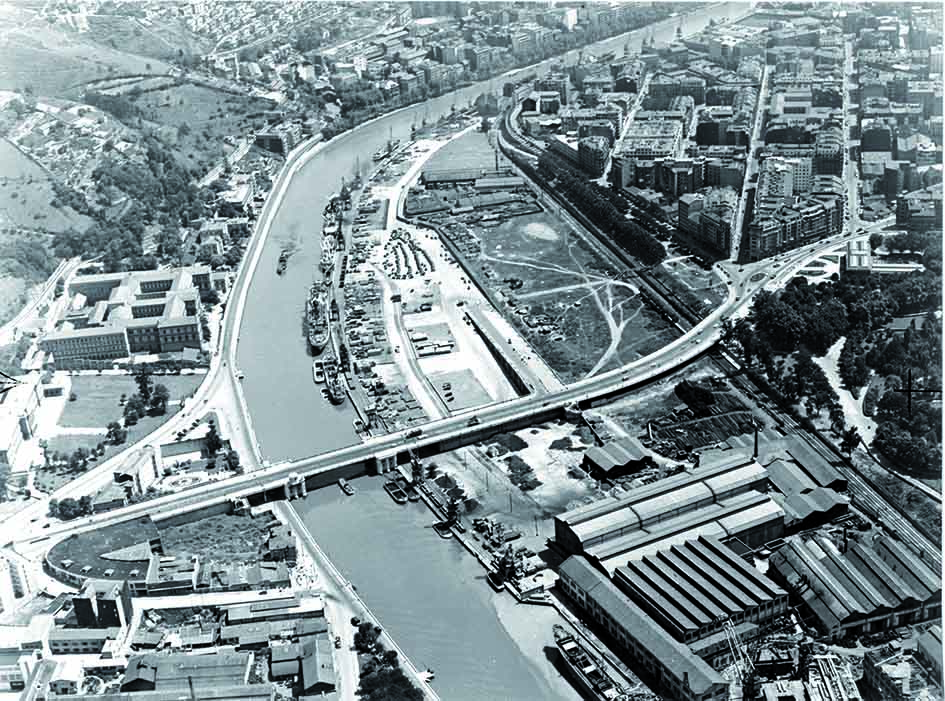
La ría de Bilbao como elemento de implantación industrial
En este ir y venir entre la memoria colectiva y la Historia, somos privilegiados testigos de la imparable transformación que se está produciendo en la vida económica, social y política de nuestro país. Si sucumbimos a la tentación de reflexionar sobre las experiencias y circunstancias de nuestra realidad, comprobamos que no son sino la reproducción de lo que cien años antes otros seres vivieron con la misma incertidumbre e inquietud. La luz de la Historia puede ayudarnos a alcanzar algunas claves que nos permitan caminar con más confianza hacia el porvenir. No olvidemos que, en opinión de George Orwell, «Quien controla el pasado, controla el futuro».
En el comercio marítimo intervienen tres elementos complementarios entre sí: el puerto, el buque y la mercancía. El puerto es el elemento estático, lo que tiene que ver con la estructura física del transporte: la ejecución de las obras, conservación del calado, edificios e instalaciones en los muelles, el utillaje, etc. El buque y la mercancía constituyen el componente dinámico de la actividad comercial, lo que concierne a la navegación: tráfico marítimo, fondeo, amarraje, atraque y desatraque, remolque, operaciones de carga y descarga, almacenamiento, auxilios marítimos, etc. Es indispensable que estos tres elementos se encuentren perfectamente coordinados para que se cumplan los requisitos de regularidad, frecuencia, fiabilidad, rapidez y seguridad en el transporte para que aporten el máximo rendimiento al comercio marítimo. Diríamos que la sinergia que se establece entre la mercancía, el buque y el puerto, condiciona y determina la actividad comercial marítima.
En la primera mitad del XIX la actividad comercial del puerto de Bilbao tenía como escenario dos guerras que asolaron el país: la guerra contra los franceses y la primera guerra carlista. La tradicional actividad del hierro comenzaba a modernizar sus instalaciones a mediados de siglo y la técnica había evolucionado hacia los hornos altos de carbón vegetal. Pero a mediados de la década de los ’60 del siglo XIX apareció un nuevo elemento en la actividad portuaria: la obtención de acero por medio del convertidor Bessemer, que precisaba de un mineral de hierro carente de azufre y fósforo. Éste solamente se daba en Europa en Suecia, bajo tierra, y en los montes de Triano, a cielo abierto. Así comenzó la exportación masiva del mineral de hierro provocada por una demanda importantísima proveniente del extranjero, principalmente Reino Unido. El despliegue de la actividad extractiva minera que conllevaba la afluencia de embarcaciones de mayor capacidad por una parte y los avances tecnológicos en los astilleros, casco metálico, navegación a vapor, hélice etc. por otra, provocaron la necesidad de calados superiores y de muelles de atraque adecuados. Se instalaron docenas de compañías mineras -entre ellas 64 inglesas- que emplearon a más de 15.000 personas y a finales de siglo llegaron a producir seis millones y medio de toneladas anuales de hierro, la décima parte de la producción mundial en ese momento.
El puerto de Bilbao tuvo que adaptarse para prestar servicio a la nueva actividad industrial que se iba a desarrollar. Había que acercar el mineral de hierro a los muelles, pero la carga y descarga de los buques en Bilbao sufría numerosas demoras por la dificultad para entrar y salir del puerto. La presencia de bancos de arenas movedizas en la desembocadura de la ría, con las fuertes rompientes en la misma barra, suponía un importantísimo obstáculo para el acceso al puerto, y la navegación interior sufría grandes dificultades para el desarrollo comercial. Las violentas curvas de las márgenes, la estrechez del cauce y la escasez de fondo obligaban a las embarcaciones a fondear en Olabeaga, a 4 Km del corazón de la Villa, y descargar las mercancías a gabarras para subirlas hasta Bilbao. Este gasto de gabarraje gravaba seriamente el precio final de los artículos objeto de comercio.
El acondicionamiento del puerto a las nuevas necesidades industriales, que surgieron con la industria extractiva minera y con la moderna siderurgia, estimuló el acomodo del territorio a la nueva actividad. Se desviaron ríos; se abrieron agujeros gigantes en las montañas de hierro de las que hablaba Plinio; se instalaron hornos para calcinar el hierro; se tendieron tranvías aéreos para bajarlo en baldes hasta los cargaderos del puerto, se construyeron planos inclinados para las vagonetas, y se trazó la red ferroviaria más densa de Europa: 100 km de vía férrea para 2.200 km2.
En el período de 1878 a 1902, se encauzó la ría acondicionando muelles de atraque y fondeaderos, se suprimió la barra de Portugalete permitiendo entrar buques de gran calado y se estableció un puerto exterior con calados entre 5 y 15 metros. de profundidad en bajamar equinoccial, admitiendo en estas mareas buques de hasta 15,25 metros de calado. Bilbao, que había sido tradicionalmente un centro importador de productos alimenticios y manufacturas, se convirtió en un puerto exportador de derivados de hierro y de productos industriales fabricados en las márgenes de la ría.
Para la explotación del mineral era necesaria la combinación de tres elementos: la Extracción, el Transporte y la Mano de Obra. Sin el ánimo de ser exhaustiva, intentaré explicar mediante el cuadro adjunto las interrelaciones que se establecieron con el desarrollo sincronizado de los tres y cómo el efecto dominó jugó a favor en la economía de Bizkaia entre 1880 y 1910.
Extracción
Siderurgia y metallurgia
A la par que creció la extracción minera, surgió la fabricación de lingote para acero Bessemer, que permitía abaratar los costes de transporte, pues no era lo mismo transportar una tonelada de mineral, de la que se beneficiaba el 50% de hierro, que una tonelada de lingote, que, además ocupaba menor espacio en los buques.
El efecto de arrastre del mineral de hierro sobre el resto de la economía. (Fuente: Elaboración propia)
El primer intento de montar una moderna siderurgia en la margen izquierda surge de las manos de capital inglés con la sociedad The Cantabrian Iron Ore Co, en 1870, que proyectaba la construcción de una gran planta siderúrgica en las marismas de Sestao. Los hornos altos comenzaban a construirse en 1871-1873 y el ferrocarril encargado de abastecerlos de mineral en 1871. Todo se paralizó con la llegada de la tercera y última guerra carlista. Por lo que la industrialización de la margen izquierda comenzó realmente en 1879 cuando Francisco de las Rivas y Ubieta compró los terrenos de los carmelitas, procedentes de la desamortización y The Cantabrian Iron Ore Co Ltd. para instalar la fábrica «San Francisco del Desierto».
De izquierda a derecha: Sociedad Altos Hornos y Fábricas de hierro y acero de Bilbao, desembocadura del río Galindo, San Francisco, Astilleros del Nervión. Aprox. 1885.
En 1882, modernizada la fábrica del Carmen de la familia Ibarra, se convirtió en la Sociedad Altos Hornos y Fábricas de hierro y acero de Bilbao. También en 1882 Víctor Chávarri junto a los Gandarias y Durañona compran los terrenos comunales de la playa de «La Punta» de Sestao se asocian con una empresa belga y crean la Sociedad Metalúrgica y Construcciones de Vizcaya que se pone en funcionamiento en 1885. Francisco de Goitia asociándose a «Echevarría Hermanos», instaló en terrenos arrendados por «La Vizcaya» la fábrica de hojalata La Iberia, que empezó a funcionar en 1887 para fabricar hierro y acero galvanizados, hojalata, sartenes, latas de conservas, etc. En 1902 se fusionaron «Altos Hornos y Fábricas de Hierro y Acero de Bilbao», «La Vizcaya» y «La Iberia» para constituir Altos Hornos de Vizcaya, con una nómina de 6.139 empleados. La fábrica San Francisco se incorporó en 1924.
A partir de 1902, fecha de la formación de AHV, la venta de lingote a países extranjeros disminuyó hasta casi desaparecer de la exportación en 1910, debido a una mayor producción de hierros y aceros transformados en las fábricas locales, dejando paso a la exportación de productos semi-elaborados como el hierro en barras, o de tercera transformación, como los tubos, cables, alambres y muelles.
A la vez Federico Echevarría instaló en Recalde, en 1878, un taller de laminación y estampación de hojalata, que amplió para fabricar caldererías y baños galvanizados. En 1920 se convirtió en la Sociedad Anónima Echevarría que fabricaba los aceros HEVA. En 1894 instaló el primer horno de acero Siemens montado en España.
En 1890 se creó la fábrica Aurrerá que producía tuberías hierro colado, radiadores, termos y calderas. En 1918 se inauguró la Sociedad Española de Construcción Babcock & Wilcox que se dedicaba a la fabricación de calderas de vapor y posteriormente de locomotoras y de tubos de todas las clases. En 1929 se creó la General Eléctrica Española para electrificar los ferrocarriles y fabricar material eléctrico y mecánico y en 1930 se fusionó con AEG para fabricar material eléctrico.
Para abastecer la creciente demanda de talleres mecánicos, maquinarias, y mobiliario de hierro, como camas, calefacciones, cocinas, etc. surgen numerosas empresas vinculadas a las familias Ibarra, Zubiría, Allende, Chávarri, Ibáñez, etc. todas ellas con capacidad productiva como para exportar a Sudamérica y el mantenimiento de toda la maquinaria del aparato productivo, favorecerá también la compra creciente de aceites lubricantes industriales.
En el proceso de desarrollo siderúrgico, merece especial mención la compra al extranjero de hojalata que creció paralela al desarrollo de la industria conservera, hasta que a finales de siglo casi había desaparecido de las importaciones, y entraban estaño y las materias primas para su producción y comenzaba a exportarse. Esto está evidenciando la instalación de las fábricas de hojalata «La Iberia» y «La Basconia» a comienzos de los ’90, también vinculada a los Chávarri, Ibarras, Rochelt, etc. para producir hojalata.
Altos Hornos de Vizcaya. S.XX. Fecha incierta.
Combustible
El desarrollo de la industria siderúrgica indujo a una demanda creciente de combustible. La mayor parte del combustible importado se destinaba a los establecimientos siderúrgicos que lo compraban directamente. También las compañías de ferrocarril consumían suficiente como para realizar pedidos de barcos completos que lo hacían a través de agentes en el Reino Unido. Las mejoras técnicas introducidas en la siderurgia de Bizkaia produjeron una demanda creciente de carbón de cok, por hacernos una idea, la producción de cok en Bizkaia en 1907 supuso el 50% del producido en toda la península. La coquización se podía realizar por diversos sistemas, y el sistema Solvay, instalado en 1888 en «La Vizcaya» y el de «Altos Hornos de Bilbao» permitía el aprovechamiento de los subproductos derivados, lo que favoreció el desarrollo de una industria química cuyos inputs eran precisamente estos residuos. Las necesidades de combustible son generales a todas las industrias que fueron instalándose en las márgenes del Nervión, para las embarcaciones, y para cubrir las necesidades en las viviendas, por lo que para no dificultar la comprensión del cuadro no lo he señalado con flechas.
Industria química
Los subproductos procedentes de la destilación de la hulla para obtener el carbón de cok, serán la base del desarrollo de la industria química en Bizkaia. De la destilación de la hulla, se obtenía gas para el alumbrado, alquitrán, amoníaco que, tratado con ácido sulfúrico, producía abonos (sulfato amónico), se obtienen además los aceites ligeros, como el benzol, y sus derivados: el benceno, materia prima para las anilinas y los colorantes y el tolueno base de los explosivos; los aceites intermedios, como la naftalina y el ácido fénico, utilizados como colorantes y para la producción de explosivos; y los aceites creosotados como el alquitrán, que alcanzaba a finales de siglo un precio más alto que el carbón de cok.
La extracción de mineral potenció y favoreció también la industria química de explosivos. La primera fábrica registrada de explosivos industriales, en 1867, es la compañía inglesa Davey, Bickford, Smith & Co, propietaria de la fábrica de mechas próxima a los yacimientos mineros. La Sociedad Española de la Pólvora Dinamítica – Privilegio de A. Nobel se creó en 1872, teniendo como socios a Alfred Nobel, a los ingenieros Eugeine Pereire, J. Levy y Collet, y a François Barbe, Poncelet, entre otros. En 1884 «La Dinamita» cambió de nombre a S.A. Española de la Dinamita y de Productos Químicos, que en 1896 se convirtió en Unión Española de Explosivos.
Fábrica de productos químicos de alquitrán, Luchana-Baracaldo (Vizcaya).
En 1888 casi todos los participantes en las siderurgias y en las explotaciones mineras se unieron para fundar la Sociedad Anónima Vasco – Asturiana Santa Bárbara (Víctor Chávarri, Pedro P. Gandarias, Tomás Allende, Pedro Galíndez, Agustín Iza, Antonio Ruiz de Velasco, Edmundo Mac Lennan, Ramón de la Sota, etc.). La compañía Eugenio Erhardt y Cía era a su vez la representante para Bizkaia de la empresa alemana Deutshche Sprengstoff que instalaron en Burceña la fábrica de explosivos El Sol.
La producción de ácido sulfúrico solía tomarse como base para estimar la situación industrial de un país, porque es el producto que interviene en el proceso industrial de mayor número de empresas. Entre las aplicaciones industriales del ácido sulfúrico estaban los explosivos, el celuloide, los nitratos, la seda artificial, la glucosa, el almidón, pilas y acumuladores, etc… Dada la dificultad para trasladarlo (al ser tan corrosivo había que trasladarlos en vasijas de cristal), comienzan a instalarse fábricas de este producto. La «Dinamita» abrió en Deusto en 1884 la planta de ácido sulfúrico que utilizaba como input, para fabricación de la dinamita y en 1896 construyó en la curva de Elorrieta, a orillas del Nervión, una fábrica para la elaboración de productos químicos, abonos y ácido sulfúrico por el procedimiento de cámaras.
Otra de las industrias químicas que se desarrollaron en el último cuarto del siglo pasado fue la del refino de petróleo, que ya se comercializaba desde 1868. Este producto procedía de Estados Unidos por ser más adecuado que el de Rusia para el alumbrado y para los motores. En 1878 se estableció en la margen izquierda del Nervión la empresa vinculada a capital francés Fourcade y Gurtubay, para refino de petróleo. Durante bastante tiempo, la tercera parte del petróleo que entraba en la península, lo hacía por el puerto de Bilbao. En 1889 se había instalado en Elorrieta, la compañía inglesa de refino de petróleo Burt, Boulton & Haywood que aprovechaba los residuos de la destilación del refino del petróleo y utilizando el benzol y el alquitrán procedentes de la destilación del cok, producía brea y creosota, esta última empleada en la prolongación de la vida de las traviesas de ferrocarril. El ácido sulfúrico producido en Elorrieta por «La Dinamita» era adquirido en su mayor parte por esta compañía inglesa que lo utilizaba para el refino del petróleo y para la fabricación de anilinas y colorantes. Como para el destilado necesitaban generar frío, estas dos empresas fueron las primeras abastecedoras de hielo a la población de Bilbao.
En 1912 se instaló en Lutxana, Barakaldo, L’Eglise y Cía, de capital francés, que se dedicaba a la fabricación de productos derivados del alquitrán, procedente de la destilación de la hulla de las baterías de cok de los Altos Hornos, en 1923 pasó a llamarse Sociedad Bilbaína de Maderas y Alquitranes S.A., y en 1929, «Altos Hornos de Vizcaya» compró ambas empresas.
En la industria química, los subproductos de la fabricación de uno, son las materias primas de otros, así en 1886, el bisulfato de sosa obtenido de la fabricación de ácido nítrico proporcionaba ácido clorhídrico y sulfato de sosa. En los años siguientes la «Sociedad Española de la Dinamita y de Productos Químicos» comenzaron a fabricar sulfato de hierro, anhídrido sulfuroso y sulfato de cobre. Estos productos comenzaron a exportarse a finales de siglo. En el último cuarto del siglo XIX, la compra de nitrato de sosa y de sulfato de amonio por el puerto de Bilbao evidencian el desarrollo de la industria química vinculada a los abonos, y abastecedora de productos químicos demandados por varias industrias.
Productos químicos y abonos minerales. Fábricas en Vizcaya.
La irrupción de los abonos químicos en el movimiento portuario, superfosfatos, escorias básicas, y sulfato amónico es debida a la reutilización de los subproductos de explosivos y del carbón de cok. Para aprovechar los subproductos de la fabricación de nitroglicerina «La Dinamita» consiguió en 1884 la patente para la fabricación de superfosfatos, utilizando el ácido sulfúrico para enriquecer los fosfatos naturales. En 1884 se constituyó en Bilbao La Cantábrica, Sociedad Anónima Española de Fosfatos Solubles. En 1903 se constituyó la Sociedad General de Industria y Comercio para desglosar la fabricación de todos los productos químicos y fertilizantes de la de los explosivos y comienzan a verse exportaciones de abonos químicos, en el movimiento portuario.
A comienzos de siglo es evidente la presencia de todas estas empresas químicas en las márgenes del Nervión por la entrada a través del puerto de sus materias primas: carbonato puro e impuro, bicarbonato de potasa, clorato de potasa y sulfatos de sosa y potasa. Del mismo modo, disminuyen las entradas de ácido sulfúrico y comienzan a embarcarse abonos, tanto por cabotaje (un 70%) como para el comercio exterior, principalmente para América Latina.
Cargaderos de mineral en la ría de Bilbao, de la Compañía Orconera, hacia 1900.
Transporte
Ferrocarriles
Una vez extraído el mineral se trasladaba hasta el puerto y hasta las factorías establecidas en sus márgenes. Así comenzaron a instalarse ferrocarriles mineros, hasta construirse casi 100 km de vía férrea que servían a las compañías mineras y siderúrgicas: algunos llegaban directamente a las fábricas. Tanto los 9 ferrocarriles mineros como los 11 tranvías aéreos, los 2,25 km de los 13 planos inclinados, las cadenas sin fin, y los 26 cargaderos instalados en la ría, demandaban maquinaria, talleres de mecánica, industria metalúrgica, tornillería, herramientas, madera y cordelería.
Barcos
El transporte del mineral en barco, a su vez, demandaba diques para reparaciones, velamen, suministros navales, calderería, astilleros y compañías navieras, que, con las mejoras técnicas en la navegación a vapor comenzaron a establecer líneas regulares, que demandaban más metros de muelle para atracar, más superficie para descargar, y mejor utillaje para acelerar el proceso de carga y descarga y abaratar así las estadías.
Astilleros Euskalduna. Hacia 1920.
Los cascos de madera fueron paulatinamente sustituidos por cascos de hierro que permitían aumentar el tamaño de los navíos, lo que a su vez proporcionaba una mayor capacidad de carga. El empleo del acero para los cascos permitió reducir el espesor de los materiales y economizar en el peso de los mismos lo que repercutía también en un aumento de fuerza de la máquina, el aumento del tamaño de los cascos fue espectacular pero pocos puertos estaban preparados para acoger esas «poblaciones flotantes». Las instalaciones portuarias se vieron obligadas a adaptarse. El vapor y la hélice proporcionaron mayor seguridad y navegabilidad a las embarcaciones y la gran ventaja de navegar independiente de la fuerza y dirección del viento o de la mar permitió el desarrollo de líneas regulares y esto el despliegue de las compañías navieras. Este hecho incrementó considerablemente el rendimiento de los muelles.
La primera línea regular con América del Sur fue la alemana Hamburgo-Sudamérica con escala en Bilbao que empezó a funcionar en agosto de 1899. A esta línea le siguieron otras que en total proporcionaban 16 salidas regulares mensuales con destinos hacia Uruguay, Argentina, Cuba, México, Puerto Rico, Guatemala, Chile, Brasil, y Nueva York.
También es reseñable la presencia de numerosos astilleros de madera y talleres de reparación de buques instalados a orillas del Nervión, como la Compañía de los Diques Secos, fundada en 1868 en Olabeaga, que se instaló en el viejo dique de Domingo Zubiría y que en 1900 pasó a ser la Compañía Euskalduna de Construcción y Reparación de Buques. Cabe también aquí mencionar el nacimiento de Astilleros del Nervión y La Sociedad Española de Construcción Naval. Este incremento de la navegación que favorece la instalación de talleres tanto de fundición como de reparación de maquinaria, se deja ver claramente en la entrada por mar de toneladas de máquinas, en gran parte máquinas motrices, de vapor, gas, hidráulica para las industrias nacientes.
Industria de la construcción: cemento
Las importantes obras llevadas a cabo en el puerto y el incremento de población, con la consiguiente demanda de viviendas, que se experimentó en toda el área de influencia del puerto, propiciaron una importante demanda de hormigón de cemento Portland. En la construcción del puerto exterior, y en la red de saneamiento se utilizaron grandes cantidades de cemento Portland que fue importado al principio de Francia, de Boulogne. Los bloques de cemento Portland eran fabricados por el taller que la Coiseau, Couvreux y Allard, contratistas de las obras del puerto, habían instalado en Axpe. Este incremento en la demanda es la base de la fundación de la Sociedad General de Cementos Portland, que se instaló en Sestao con capital francés, a comienzos de siglo XX y otras empresas. Más de la mitad del «material para construcción» de las compras a principios de siglo era el cemento. La «Sociedad General de Cementos Portland» que pasó a ser una de las más importantes en su ramo de actividad, aprovechaba las escorias de «La Vizcaya» y contaba con personal técnico muy cualificado, lo que le hizo ser, en poco tiempo bastante rentable.
Mano de obra
Industria de la construcción: viviendas
Como consecuencia del desarrollo económico verificado, se asentó en las márgenes de la ría una creciente población que reclamaba bienes de equipo y de consumo y que proporcionó una demanda importante de viviendas con el consiguiente aumento en las importaciones de tablas de madera, cristal, porcelana, etc. para suministrar, en el último cuarto de siglo, la construcción del ensanche de Bilbao y de otros municipios ribereños. Entre 1886 y 1889 hubo una especial fiebre edificadora y se construyeron 159 edificios y reconstruido 181, un total 240 edificios con una media de 5 pisos cada uno.
Tinglados y terminal de contenedores en la campa de los ingleses. En el cuadrante superior izquierdo se puede ver Euskalduna. 1971.
En la década de los ’90 del siglo XIX se establecieron numerosas empresas de cemento comprimido y cal hidráulica, de cemento hidráulico, de baldosas, de cerámica para la construcción, de ladrillos refractarios y tejas en Basurto, serrerías de mármol, etc. destinadas a abastecer la demanda del ensanche de las poblaciones de ambas márgenes de la ría.
Madera
Hay que decir que las traviesas de los numerosos ferrocarriles que atravesaban el reducido suelo de Bizkaia, eran confeccionadas en su mayoría con el roble autóctono, llevando esta práctica a la casi deforestación del país, y aunque hubo intentos por sustituirlas por pino francés, éste no daba los resultados esperados.
Tras el fin de la última guerra carlista, y puesta en marcha la anexión de Abando, se produjo un fuerte aumento en las compras de madera dedicado a la reconstrucción de la ciudad y su entorno. En este período surgieron compañías constructoras como Aguirre Hermanos y Cía, en 1888, Sociedad de Terrenos La Concordia, en 1889, La Perla en 1891, o A. Ruiz de Velasco y Cía en 1894.
Las tablas para construcción de todo tipo, de embarcaciones y de viviendas, estaban controladas por firmas noruegas y utilizaban fundamentalmente barcos con bandera extranjera para su transporte. Esta madera venía también de Suecia, Bélgica y Holanda e incluso de Rusia. Esta importación favoreció el surgimiento de cinco talleres de serrería de maderas, movidos todos ellos por máquinas de vapor. En 1895 están reseñadas La Compañía de Maderas de Sorensen Yakhelln & Co que ya funcionaba en 1874 y que posteriormente pertenecerá a Julio Larsen, Hilario Lund y Clausen (ubicada donde ahora se asienta el Guggenheim), Francisco Arana y Lupardo, anterior astillero de barcos de madera, ambas en la margen izquierda del Nervión, Arana e Hijos, Hilario Latiegui y Uridi en la margen derecha.
En 1891 entran con fuerza listones de madera para entarimado que, provenientes de Las Landas se cargaban en Bayona, éstos y los procedentes de Bélgica, eran de baja calidad y se usaban principalmente para las «casas baratas».
Cristal
Las viviendas y establecimientos precisaban de vidrios planos, y la empresa Vidrios de Lamiaco, fue fundada en 1890, y junto con La Vizcaína y La Jerezana se fusionaron para formar la Compagnie Genérale des Verrières Espagnoles.
Muelles de la Vasco-Andaluza. 1930.
Industria textil
También la industria textil se vio beneficiado de este efecto de arrastre. El transporte de mineral y la consiguiente afluencia de buques atrajo una demanda de las compras de hilaza de cáñamo, lino y yute. El cáñamo se utilizaba principalmente para jarcia y cordelería para el arrastre de vagonetas, para el amarre de los buques y para la fabricación de alpargatas, cuya industria creció vinculada también a la explotación minera. Se instalaron nbumerosas cordelerías y fábricas de jarcia y cables, una de las más destacadas a mediados del siglo XIX, Cordelería de Zorroza, pertenecía a la familia Ibarra, otra de ellas Cordelería y efectos Navales, fundada en 1839 estaba situada en Olabeaga y Bilbao Goyoaga, situada en 1833 en la vega de San Mamés, dedicada a la fabricación de cordelería y velamen.
El yute no se utilizaba para la fabricación de cuerdas porque se pudre fácilmente, la parte inferior de sus tallos, se empleaba en la fabricación de papel. El yute procedente de Inglaterra era utilizado para tramas y urdimbres en la fabricación de tejidos y con el procedente de Bélgica, se elaboraban mechas para minas. El lino se utilizaba en la fabricación de velas para las embarcaciones que abarrotaban la ría. La pita se utilizaba principalmente para cordelería. El abacá, se aplicaba para cordones finos, redecillas, bolsas y para tramas de tela de tapicería.
Desaparece la importación por el puerto de hilaza y a comienzos del siglo XX aparece la importación de materias primas para las industrias textiles y la industria del papel. Además, tratada con ácido sulfúrico, la celulosa que contienen alguna de estas fibras, se convierte en glucosa para la fabricación de alcoholes.
La fabricación de alpargatas es una actividad textil creciente, no siendo desdeñables los 4.000 pares que se exportaron en 1867 (equivalente a 1,6 Tm) por una gran fábrica, la de Máximo Aguirre, Fábrica de lencería Miraflores en el Pontón y que posteriormente, en 1864 será vendida a Eduardo Coste y Vildósola que fabricaba alpargatas a máquina. Vda. e Hijos de J. Power, que además de las alpargatas fabricaban sacos y tejidos de yute y cordelería situada en La Peña. También existían numerosos pequeños artesanos que se dedicaban a este oficio en las inmediaciones de Portugalete. Las exportaciones hacia Suramérica, para hacernos una idea fueron de cerca de 360.000 pares de alpargatas en 1907.
Entre la industria textil cabe mencionar la fábrica de Santos López de Letona de algodón en Galdácano y La Encartada, fábrica de boinas, instalada en Balmaseda en 1891, actual museo, La Conchita fundada en 1903 por el Conde de Aresti, y Gastón y Daniela, principal importador de textiles.
Industria papalera
En 1897 la industria papelera comienza a manifestar su capacidad exportadora. Aparecen el papel continuo y el papel impreso, que, probablemente fabricaba la Papelera del Cadagua, que, fundada en 1890, estaba vinculada a Víctor Chávarri y a los Ibarra. También se fundó en ese año la Papelera Vizcaína, vinculada a Echevarría. Ambas empresas se fusionarán en 1901, junto con «Papelera de Vedia», y constituirán la Papelera Española. Ésta comienza a tener un peso importante en las exportaciones. A finales de siglo se refleja la entrada de pasta para fabricar papel, que se importaba de Suecia y Noruega.
Tradicionalmente existían además en Bizkaia otras industrias que, con las innovaciones tecnológicas, fueron madurando hasta alcanzar gran prosperidad. Estas son la industria pesquera y su complementaria la conservera. La industria pesquera que se desarrollaba fundamentalmente en Bermeo en la década de los ’80 delsiglo XIX, ocupaba a unas 550 embarcaciones. Esta industria favoreció el desarrollo de las conservas alimenticias propiciando la exportación y demandando gran cantidad de madera para el embalaje de los botes y latas.
En definitiva, la riqueza de Bizkaia debe su origen a la naturaleza de su suelo y a la capacidad de sumar, a la tradicional actividad mercantil, las mejoras técnicas de la industria. Las inversiones a largo plazo repercutieron en la modernización industrial dejando las bases firmemente asentadas. Con la perspectiva del siglo XXI, podríamos decir que la adaptación de la margen izquierda de la Ría de Bilbao y del puerto exterior a las necesidades industriales ha permitido readaptarse a las nuevas necesidades, incorporando a la ciudad esos espacios industriales, desplazando hacia el mar la actividad portuaria.
Tramo de concentración de industrias en la Ría de Bilbao. Diciembre de 1905.7
Head Image: Vista aérea de la terminal de contenedores en pleno corazón de la Villa. Lugar donde estaba ubicado el cementerio británico, ocupado actualmente por el Guggenheim. 1954.
